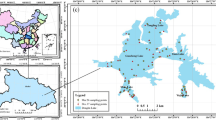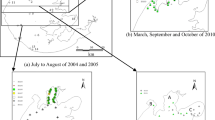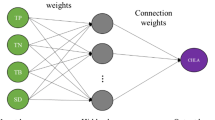Abstract
This paper aims at combining principle component analysis (PCA) and artificial neural network (ANN) algorithm to predict chlorophyll a concentration in Dianshan Lake, Shanghai, eastern China. Firstly, based on field hyperspectral measurements, the sensitive wavelengths were selected as the input variables to build the basic ANN model, and the estimate accuracy (R 2) reached 0.85. In order to improve the accuracy and stability of the ANN model, the total nitrogen, total phosphorus, chemical oxygen demand, dissolve oxygen, and dissolved potential of hydrogen were selected as additional input variables. Consequently, the model accuracy increased to 0.9091. Further, aiming at eliminating the effect of inter-correlation of input variables, the PCA method was utilized to reduce the dimension of input variables. The result shows that the combined PCA–ANN model can reach an estimated accuracy with R 2 = 0.9184 and RMSE < 5.6 mg m−3. Moreover, the stability and performance of the enhanced model was further evaluated by cross-validation of PCA–ANN model output and in situ measured datasets. The model sensitivity test through adding 10 % Gauss white noise to the input variables also proved that the enhanced PCA–ANN model has better noise tolerance ability.









Similar content being viewed by others
References
Barbieri P et al (1999) Modeling bio-geochemical interactions in the surface waters of the Gulf of Trieste by three-way principal component analysis (PCA), vol 398. Elsevier, Amsterdam
Bricaud A, Babin M, Morel A, Claustre H (1995) Variability in the chlorophyll-specific absorption-coefficients of natural phytoplankton—analysis and parameterization. J Geophys Res-Oceans 100:13321–13332. doi:10.1029/95jc00463
Buckton D, O’Mongain E, Danaher S (1999) The use of neural networks for the estimation of oceanic constituents based on the MERIS instrument. Int J Remote Sens 20:1841–1851. doi:10.1080/014311699212515
Çamdevýren H, Demýr N, Kanik A, Keskýn S (2005) Use of principal component scores in multiple linear regression models for prediction of Chlorophyll a in reservoirs. Ecol Model 181:581–589. doi:10.1016/j.ecolmodel.2004.06.043
Chaloulakou A, Saisana M, Spyrellis N (2003) Comparative assessment of neural networks and regression models for forecasting summertime ozone in Athens. Sci Total Environ 313:1–13. doi:10.1016/S0048-9697(03)00335-8
Cheng X, Li XP (2010) Long-term changes in nutrients and phytoplankton response in Lake Dianshan, a shallow temperate lake in China. J Freshw Ecol 25:549–554. doi:10.1080/02705060.2010.9664404
Cipollini P, Corsini G, Diani M, Grasso R (2001) Retrieval of sea water optically active parameters from hyperspectral data by means of generalized radial basis function neural networks. Ieee T Geosci Remote 39:1508–1524. doi:10.1109/36.934081
Duan H, Ma R, Xu J, Zhang Y, Zhang B (2010) Comparison of different semi-empirical algorithms to estimate chlorophyll a concentration in inland lake water. Environ Monit Assess 170:231–244. doi:10.1007/s10661-009-1228-7
Flink P, Lindell T, Ostlund C (2001) Statistical analysis of hyperspectral data from two Swedish lakes. Sci Total Environ 268:155–169. doi:10.1016/S0048-9697(00)00686-0
Flores-de-Santiago F, Kovacs JM, Flores-Verdugo F (2013) The influence of seasonality in estimating mangrove leaf chlorophyll a content from hyperspectral data. Wetl Ecol Manag 21:193–207. doi:10.1007/s11273-013-9290-x
Gitelson AA, Gurlin D, Moses WJ, Barrow T (2009) A bio-optical algorithm for the remote estimation of the chlorophyll a concentration in case 2 waters. Environ Res Lett 4: 045003. doi:10.1088/1748-9326/4/4/045003
Hakanson L, Malmaeus JM, Bodemer U, Gerhardt V (2003) Coefficients of variation for chlorophyll, green algae, diatoms, cryptophytes and blue-greens in rivers as a basis for predictive modelling and aquatic management. Ecol Model 169:179–196. doi:10.1016/S0304-3800(03)00269-2
Jamet C, Thiria S, Moulin C, Crepon M (2005) Use of a neurovariational inversion for retrieving oceanic and atmospheric constituents from ocean color imagery: a feasibility study. J Atmos Ocean Technol 22:460–475. doi:10.1175/JTECH1688.1
Jeong KS, Kim DK, Joo GJ (2006) River phytoplankton prediction model by Artificial Neural Network: model performance and selection of input variables to predict time-series phytoplankton proliferations in a regulated river system. Ecol Inform 1:235–245. doi:10.1016/j.ecoinf.2006.04.001
Johnson RA, Wichern DW (1982) Applied multivariate statistical analysis. Prentice-Hall Inc., Englewood Cliffs
Keiner LE, Yan X-H (1998) A neural network model for estimating sea surface chlorophyll and sediments from thematic mapper imagery. Remote Sens Environ 66:153–165. doi:10.1016/S0034-4257(98)00054-6
Kilham NE, Roberts D (2011) Amazon River time series of surface sediment concentration from MODIS. Int J Remote Sens 32:2659–2679. doi:10.1080/01431161003713044
Koponen S, Pulliainen J, Kallio K, Hallikainen M (2002) Lake water quality classification with airborne hyperspectral spectrometer and simulated MERIS data. Remote Sens Environ 79:51–59. doi:10.1016/S0034-4257(01)00238-3
Ma RH, Dai JF (2005) Investigation of chlorophyll a and total suspended matter concentrations using Landsat ETM and field spectral measurement in Taihu Lake. China Int J Remote Sens 26:2779–2795. doi:10.1080/01431160512331326648
Mobley CD et al (2005) Interpretation of hyperspectral remote-sensing imagery by spectrum matching and look-up tables. Appl Opt 44:3576–3592
Perkins RG, Underwood GJC (2000) Gradients of chlorophyll a and water chemistry along an eutrophic reservoir with determination of the limiting nutrient by in situ nutrient addition. Water Res 34:713–724
Petersen W, Bertino L, Callies U, Zorita E (2001) Process identification by principal component analysis of river water-quality data. Ecol Model 138:193–213. doi:10.1016/S0304-3800(00)00402-6
Ranković V, Radulović J, Radojević I, Ostojić A, Čomić L (2010) Neural network modeling of dissolved oxygen in the Gruža reservoir, Serbia. Ecol Model 221:1239–1244. doi:10.1016/j.ecolmodel.2009.12.023
Raudys A, Long JA (2001) MLP based linear feature extraction for nonlinearly separable data. Pattern Anal Appl 4:227–234. doi:10.1007/s100440170001
Ritchie JC, Cooper CM, Schiebe FR (1990) The relationship of MSS and TM digital data with suspended sediments, chlorophyll, and temperature in Moon Lake, Mississippi. Remote Sens Environ 33:137–148. doi:10.1016/0034-4257(90)90039-O
Schmidt KS, Skidmore AK (2001) Exploring spectral discrimination of grass species in African rangelands. Int J Remote Sens 22:3421–3434. doi:10.1080/01431160152609245
Singh KP, Malik A, Mohan D, Sinha S (2004) Multivariate statistical techniques for the evaluation of spatial and temporal variations in water quality of Gomti River (India)—a case study. Water Res 38:3980–3992. doi:10.1016/j.watres.2004.06.011
Singh KP, Basant A, Malik A, Jain G (2009) Artificial neural network modeling of the river water quality—a case study. Ecol Model 220:888–895. doi:10.1016/j.ecolmodel.2009.01.004
Steinberg CEW, Hartmann HM (1988) Planktonic bloom-forming cyanobacteria and the eutrophication of lakes and rivers. Freshw Biol 20:279–287. doi:10.1111/j.1365-2427.1988.tb00452.x
Stevens J (1986) Applied multivariate statistics for the social sciences. L. Erlbaum Associates Inc., Hill Sdale, p 515
Tanaka A, Kishino M, Doerffer R, Schiller H, Oishi T, Kubota T (2004) Development of a neural network algorithm for retrieving concentrations of chlorophyll, suspended matter and yellow substance from radiance data of the ocean color and temperature scanner. J Oceanogr 60:519–530. doi:10.1023/B:Joce.0000038345.99050.C0
Tang JW, Tian GL, Wang XY, Wang X, Song Q (2004) The methods of water spectra measuring and analysis I: above-water method. J Remote Sens 8(1):37–44
Tufford DL, McKellar HN (1999) Spatial and temporal hydrodynamic and water quality modeling analysis of a large reservoir on the South Carolina (USA) coastal plain. Ecol Model 114:137–173. doi:10.1016/S0304-3800(98)00122-7
Tzortziou M, Herman JR, Gallegos CL, Neale PJ, Subramaniam A, Harding LW, Ahmad Z (2006) Bio-optics of the Chesapeake Bay from measurements and radiative transfer closure. Estuar Coast Shelf Sci 68:348–362. doi:10.1016/j.ecss.2006.02.016
Vilas LG, Spyrakos E, Palenzuela JMT (2011) Neural network estimation of chlorophyll a from MERIS full resolution data for the coastal waters of Galician rias (NW Spain). Remote Sens Environ 115:524–535. doi:10.1016/j.rse.2010.09.021
Vincent RK, Qin X, McKay RML, Miner J, Czajkowski K, Savino J, Bridgeman T (2004) Phycocyanin detection from LANDSAT TM data for mapping cyanobacterial blooms in Lake Erie. Remote Sens Environ 89:381–392. doi:10.1016/j.rse.2003.10.014
Wang D, Feng XZ, Ma RH, Kang GD (2007) A method for retrieving water-leaving radiance from Landsat TM image in Taihu Lake, east China. Chin Geogr Sci 17:364–369. doi:10.1007/s11769-007-0364-7
Yacobi YZ, Moses WJ, Kaganovsky S, Sulimani B, Leavitt BC, Gitelson AA (2011) NIR-red reflectance-based algorithms for chlorophyll a estimation in mesotrophic inland and coastal waters: Lake Kinneret case study. Water Res 45:2428–2436. doi:10.1016/j.watres.2011.02.002
Zhang TL, Fell F, Liu ZS, Preusker R, Fischer J, He MX (2003) Evaluating the performance of artificial neural network techniques for pigment retrieval from ocean color in case I waters. J Geophys Res-Oceans 108: 3286. doi:10.1029/2002jc001638
Zhang YL, Feng LQ, Li JS, Luo LC, Yin Y, Liu ML, Li YL (2010) Seasonal-spatial variation and remote sensing of phytoplankton absorption in Lake Taihu, a large eutrophic and shallow lake in China. J Plankton Res 32:1023–1037. doi:10.1093/plankt/fbq039
Zhou L, Xu B, Ma W, Zhao B, Li L, Huai H (2013) Evaluation of hyperspectral multi-band indices to estimate chlorophyll a concentration using field spectral measurements and satellite data in Dianshan Lake, China. Water 5:525–539. doi:10.3390/w5020525
Zhou L, Roberts DA, Ma W, Zhang H, Tang L (2014) Estimation of higher chlorophylla concentrations using field spectral measurement and HJ-1A hyperspectral satellite data in Dianshan Lake, China. ISPRS J Photogramm Remote Sens 88:41–47. doi:10.1016/j.isprsjprs.2013.11.016
Zimba PV, Gitelson A (2006) Remote estimation of chlorophyll concentration in hyper-eutrophic aquatic systems: model tuning and accuracy optimization. Aquaculture 256:272–286. doi:10.1016/j.aquaculture.2006.02.038
Acknowledgments
This work was jointly funded by National Natural Science Foundation of China (Grant No. 41001234 and 41171432), Shanghai Municipal Natural Science Foundation of China (Grant No. 15ZR1404000), and specialized Research Fund for the Doctoral Program of Higher Education of China (2010007120013). The authors are grateful to the anonymous reviewers for their valuable comments on this manuscript.
Author information
Authors and Affiliations
Corresponding author
Rights and permissions
About this article
Cite this article
Zhou, L., Ma, W., Zhang, H. et al. Developing a PCA–ANN Model for Predicting Chlorophyll a Concentration from Field Hyperspectral Measurements in Dianshan Lake, China. Water Qual Expo Health 7, 591–602 (2015). https://doi.org/10.1007/s12403-015-0175-5
Received:
Revised:
Accepted:
Published:
Issue Date:
DOI: https://doi.org/10.1007/s12403-015-0175-5




